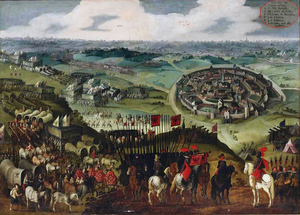Siege of Aachen (1614)
| Siege of Aachen | |||||||
|---|---|---|---|---|---|---|---|
| Part of War of the Jülich Succession | |||||||
 The siege of Aachen by the Spanish Army of Flanders under Ambrogio Spinola in 1614. Oil on canvas. Attributed to Pieter Snayers. |
|||||||
|
|||||||
| Belligerents | |||||||
|
|
|
||||||
| Commanders and leaders | |||||||
| George von Pulitz |
|
||||||
| Strength | |||||||
| 600 regulars | 15,000 | ||||||
| Casualties and losses | |||||||
| None | None | ||||||
The Siege of Aachen took place in late August 1614, when the Spanish Army of Flanders, led by Ambrogio Spinola, 1st Marquis of the Balbases, marched from Maastricht to Germany to support Wolfgang Wilhelm, Count Palatine of Neuburg, during the War of the Jülich Succession. Despite its status as a free imperial city, Aachen was under the protection of John Sigismund of Brandenburg, Neunburg's ally, and then rival, in the battle for the United Duchies of Jülich-Cleves-Berg. In 1611, the Protestant population of Aachen revolted against the Catholic city council and seized power. When the Holy Roman Emperor Rudolf II, observing the Peace of Augsburg, ordered the previous state to be restored, the Protestants allied themselves with the Margraviate of Brandenburg. The unexpected arrival of a Spanish army at the gates of the city, however, caused the Protestants to lose courage and surrender Aachen to Spinola. A Catholic garrison was installed and a process of re-Catholicization began.
Aachen was a free imperial city of importance from the times of Charlemagne to the 16th century. It was the place of coronation of the King of the Germans until Maximilian II was crowned in Frankfurt in 1562. Since then, Aachen went into a slow decline. A mainly Catholic city at the time of the Peace of Augsburg, it became religiously divided in the 1560s through the immigration of Protestant refugees from the Netherlands as a consequence of the Spanish persecution during the Dutch revolt. By the 1570s Aachen's population numbered 12,000 Catholics and 8,000 Protestants. The city council and the Emperor tried to exclude the Protestants from political participation in 1581, but thanks to the economic influence of many of the Protestant citizens, Catholics were forced to allow them access to the city council. As jurisdiction over Aachen was claimed by the Duke of Jülich and the Bishop of Liege, both of them Catholics, the Catholic population appealed to the first, who complained to Emperor Rudolf II, claiming that his ecclesiastic rights over Aachen had been violated. In 1593 the Reichshofrat declared that the city council could not change the religious status of Aachen, and therefore the Calvinists had to be expelled from the council. When they tried to resist, Rudolf outlawed the city and gave the Archduke Albert, governor of the Spanish Netherlands, the task of enforcing his decision. The subsequent re-Catholicization of the city was conducted by the Archbishop of Cologne.
...
Wikipedia
